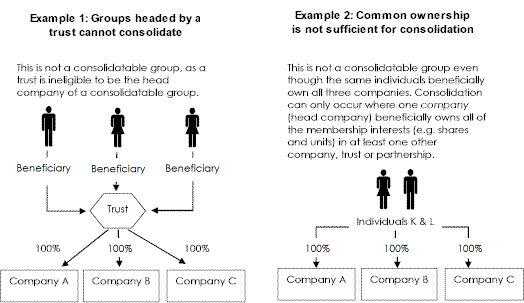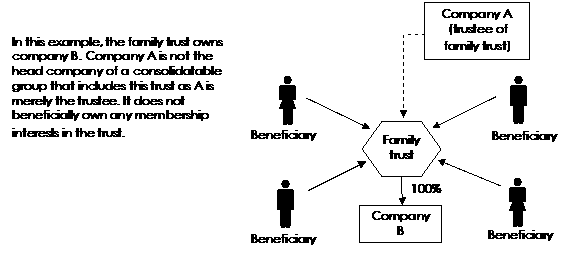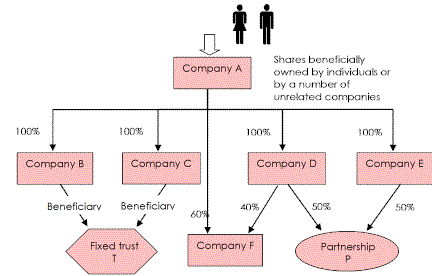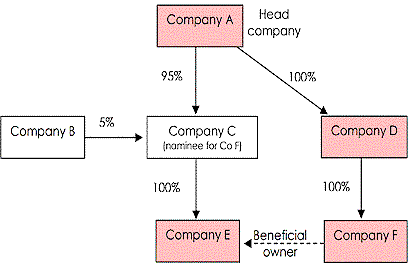Consolidation Reference Manual
You can still refer to the Consolidation reference manual for consolidation information that has not been impacted by changes in the legislation.
C1 Eligibility
C1-2 Business structures and eligibility
Structures that cannot consolidate
The following are examples of business structures that cannot consolidate under the general membership rules. → Division 703, ITAA 1997
Note that in these examples, unless otherwise indicated, all the entities are Australian residents and are not specifically excluded from being part of a consolidatable group.

Note:
A corporate unit trust or a public trading trust that satisfies the eligibility criteria (' C1-1) for being a head company (except that it is not a company) may choose to form a consolidated group as if the trust were a company. If it makes such an election, it will forever after be treated as a company for income tax purposes, even if the group later deconsolidates. " Subdivision 713-C, ITAA 1997.
Example 3: Corporate trustee is not the head company

Comments
- •
- Company A qualifies as a head company - see item 1 of section 703-15.
- •
- Companies B, C, D & E are wholly-owned subsidiaries of company A and will qualify as subsidiary members because all the requirements in item 2 of section 703-15 are met.
- •
- Company F is a wholly-owned subsidiary of company A as all of its membership interests are beneficially owned by company A and its wholly-owned subsidiary company D. It will qualify as a subsidiary member of the consolidatable group as all the other requirements of item 2 in section 703-15 have been met.
- •
- Fixed trust T is a wholly-owned subsidiary of A as all of the membership interests (rights and interests of the beneficiaries) in the trust are beneficially owned by companies B and C, which are wholly-owned subsidiaries of company A. It qualifies as a subsidiary member of the consolidatable group as all the requirements of item 2 in section 703-15 have been met.
- •
- Partnership P is a wholly-owned subsidiary of A as all of the membership interests (rights and interests of the partners) are beneficially owned by companies D and E, which are wholly-owned subsidiaries of A. Partnership P qualifies as a subsidiary member of the consolidatable group as all the other requirements of item 2 in section 703-15 are met.
Structures that can consolidate
The following are examples of business structures that contain a consolidatable group under the general membership rules. → Division 703, ITAA 1997
Example 4: Consolidatable group containing all of the different entity types
- •
- All entities are Australian residents and are eligible to be part of a consolidatable group.
- •
- Company A beneficially owns 100% of companies B, C, D and E.
- •
- The only beneficiaries of the fixed trust T are companies B and C.
- •
- Company A also beneficially owns a 60% interest in company F. The remaining 40% is beneficially owned by company D.
- •
- Companies D and E are the only partners in partnership P.

Comments
- •
- Company A qualifies as a head company - see item 1 of section 703-15.
- •
- Companies B, C, D & E are wholly-owned subsidiaries of company A and will qualify as subsidiary members because all the requirements in item 2 of section 703-15 are met.
- •
- Company F is a wholly-owned subsidiary of company A as all of its membership interests are beneficially owned by company A and its wholly-owned subsidiary company D. It will qualify as a subsidiary member of the consolidatable group as all the other requirements of item 2 in section 703-15 have been met.
- •
- Fixed trust T is a wholly-owned subsidiary of A as all of the membership interests (right and interests of the beneficiaries) in the trust are beneficially owned by companies B and C, which are wholly-owned subsidiaries of company A. It qualifies as a subsidiary member of the consolidatable group as all the requirements of item 2 in section 703-15 have been met.
- •
- Partnership P is a wholly-owned subsidiary of A as all of the membership interests (rights and interests of the partners) are beneficially owned by companies D and E, which are wholly-owned subsidiaries of A. Partnership P qualifies as a subsidiary member of the consolidatable group as all the other requirements of item 2 in section 703-15 are met.
Example 5: Minority holdings in the group
- •
- All entities are Australian residents and are eligible to be part of a consolidatable group, except Co C, Partnership P and the individuals.
- •
- Company A is the sole beneficiary of fixed trust T.
- •
- Fixed trust T owns 40% of the issued ordinary shares in company B, with the remaining 60% being held by company A.
- •
- Company A also holds 90% of the issued capital in company C, with the balance being held by an individual.

Comments
- •
- Company A qualifies as a head company - see head company requirements in item 1 of section 703-15.
- •
- Fixed trust T: All of the trust's membership interests are beneficially owned by company A, which is therefore the trust's sole beneficiary and sole member (section 960-130(1) ITAA 1997) that beneficially owns all of the trust's membership interests ' section 960-135 (ITAA 1997). Accordingly, fixed trust T is a wholly-owned subsidiary of company A ' section 703-30(1)(a). As it is also an Australian resident, is not a non-profit company, and is not specifically excluded from being a member of a consolidatable group, it qualifies as a subsidiary member.
- •
- Company B is a wholly-owned subsidiary of company A, because all of the membership interests (that is, shares) in B are beneficially owned by A (60%) and its wholly-owned subsidiary, fixed trust T (40%) ' section 703-30(1)(c). As it is also an Australian resident, an entity other than a non-profit company, and not specifically excluded from being a member of a consolidatable group, company B qualifies as a subsidiary member.
- •
- Company C is not a wholly-owned subsidiary of company A because 10% of the membership interests (that is, shares) in C are beneficially owned by an individual. As it is not a wholly-owned subsidiary it cannot be a subsidiary member of the consolidatable group.
- •
- Partnership P is not a wholly-owned subsidiary of company A as one of the partners (company C) is not a wholly-owned subsidiary of A. As it is not a wholly-owned subsidiary it cannot be a subsidiary member of the consolidatable group.
Example 6: Nominee company
- •
- Companies A, D, E and F are members of a consolidatable group of which A is the head company.
- •
- Company B is external to the group, but it has a 5% interest in company C which is 95% controlled by company A.
- •
- Company C owns all of the shares in company E, but only as nominee for company F.

Comments
- •
- Company C is not a subsidiary member of the group, as it is not a wholly-owned subsidiary of the head company - see column 4 of the table in section 703-15(2).
- •
- Company E is a wholly-owned subsidiary of the head company under section 703-30(2)(b) - all of the membership interests in company E are beneficially owned by company F, which is a wholly-owned subsidiary of company A - see section 703-30(1)(b). As company E is a wholly-owned subsidiary of the head company, and there is an entity (company C) interposed between the head company and company E, the requirements of section 703-45(1) must be met. In this example, these requirements are met, even though the interposed entity is not a subsidiary member of the group, because the membership interests in company E are held by company C only as a nominee of company F - see section 703-45(2).
References
Income Tax Assessment Act 1997 , Division 703 ; as amended by New Business Tax System (Consolidation) Act (No. 1) 2002 (No. 68 of 2002), Schedule 1
Income Tax Assessment Act 1997 , Subdivision 960-G ; as amended by New Business Tax System (Consolidation) Act (No. 1) 2002 (No. 68 of 2002), Schedule 5
Income Tax Assessment Act 1997 , Subdivision 713-C ; as inserted by Tax Laws Amendment (2004 Measures No. 2) Act 2004 (No. 83 of 2004), Schedule 2, Part 2
History
Revision History
Section C1-2 first published (excluding drafts) 2 December 2002.
Further revisions are described below.
| Date | Amendment | Reason |
|---|---|---|
| 14.7.04 | Note on recent changes to consolidation rules, p. 1. | Legislative amendments. |
| 26.10.05 | Note on changes to consolidation rules, p. 1. | Legislative amendments. |
Proposed changes to consolidation
Proposed changes to consolidation announced by the Government are not incorporated into the Consolidation reference manual until they become law.
In the interim, information about such changes can be viewed at:
- •
- http://assistant treasurer.gov.au (Assistant Treasurer's press releases)
- •
- www.treasury.gov.au (Treasury papers on refinements to the consolidation regime).
Current at 26 October 2005
